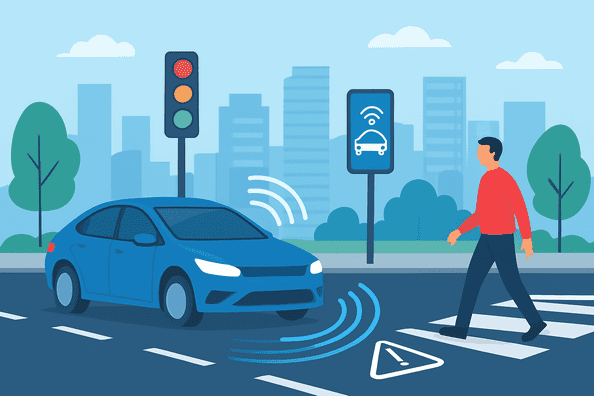Urban safety is no longer managed by traffic lights and patrol cars alone; cities are pivoting towards Smart Roads AI, using invisible but potent technologies to cut accidents and save lives. Whether in Pittsburgh, Pune, Las Vegas, or Hangzhou, the stories are increasingly similar: Smart Roads AI adapts to congestion, spots risky behavior, and orchestrates complex traffic flows—often hidden from the public eye but always working to keep road users safer. In this post, the science and stories of Smart Roads AI reveal a world where accident reduction is driven by algorithms, sensors, and predictive software that sense danger before it happens.
What is Smart Roads AI?
Smart Roads AI encompasses the mix of artificial intelligence, data sensors, and advanced connectivity embedded throughout urban infrastructure, from roadways to traffic lights and surveillance points. Unlike typical smart city narratives that spotlight flashy digital signage or public apps, much of Smart Roads AI works quietly behind the scenes:
- Adaptive traffic signal control systems
- Predictive analytics that highlight crash-prone zones
- In-vehicle warning systems and roadside data networks
Together, these systems form a digital safety net, reducing human error and responding to threats in milliseconds—much faster than human ability.
How AI Turns Roads Into Accident-Prevention Engines
Cities are increasingly transforming reactive traffic management—where police and ambulances respond only after a crash—towards Smart Roads AI solutions that operate proactively. This means using historical crash data, real-time vehicle tracking, and weather information to predict—and prevent—accidents:
- AI-enabled cameras analyze traffic flows, flagging near-misses and hazardous maneuvers as they occur.
- Predictive platforms, like Waycare, Nayan, or Netradyne, fuse data from public and private sources to identify emerging risks and dispatch warnings or changes to traffic signals before a dangerous situation escalates.
Real-World Success Stories: Cities Leveraging Smart Roads AI
Pittsburgh, USA — Decentralized, Adaptive Traffic Control
Pittsburgh’s partnership with Carnegie Mellon University brought forth SURTRAC, an AI-powered traffic signal system. This technology senses vehicle clusters, calculates optimal green-light patterns, and adapts in real time—not only cutting traffic delays by 25% and wait times by 40%, but also slashing emissions and accidents with no need for disruptive infrastructure expansion. In just nine intersections, early results showed a 31% reduction in stops and over 20% fewer emissions.
Pune, India — AI for Lawful Roads
Pune introduced an AI-driven traffic control system that reduced peak road congestion by 15-20% and caught more traffic infractions, using video analytics to monitor behavior like jaywalking and signal jumping. Compliance with traffic laws improved by 25%, and congestion dropped as AI enabled dynamic rerouting and congestion warnings.
Las Vegas & Hangzhou — Predictive Analytics in Action
In Las Vegas, predictive analytics allow authorities to forecast and mitigate risks by adjusting traffic signals and dispatching patrols based on real-time traffic and incident data. Hangzhou uses similar platforms to optimize traffic flows, reduce accident-prone congestion, and speed up emergency responses via AI-driven alerts.
The Hidden Layer: Technologies Behind the Scenes
Though drivers only notice smooth flows, the real action is hidden—within sensor grids, edge devices, and high-speed data pipes.
- Connected car sensors track braking, swerving, and lane changes to spot soon-to-be accident zones.
- Dashcams, like Driveri, use embedded AI to analyze driving behavior and environmental hazards, delivering real-time alerts and capturing the root causes of near-misses.
Edge computing allows these devices to process and respond instantly, rather than waiting for cloud-based human review, resulting in substantially quicker preventive interventions.
Vehicles and Infrastructure: AI Makes Every Mile Safer
Not only do road-based systems operate quietly, but vehicles themselves are evolving into nodes of the Smart Roads AI network.
Lane Departure Warning (LDW) and Lane Keeping Assistance (LKA) systems use cameras and AI to keep cars safely within lanes, reducing crashes by up to 30% according to studies on Swedish and US roads.
Blind Spot Detection (BSD) systems, often in rearview mirrors, cut lane-change crashes by 14%, helping ensure that drivers are aware of hidden hazards.
Automatic Emergency Braking (AEB) and adaptive cruise settings react millisecond-quickly to impending dangers, helping prevent rear-end and intersection accidents.
Balanced Perspectives: The Opportunities and Challenges
Unseen Benefits
Smart Roads AI is more than statistics; it fosters intangible gains such as improved peace of mind for drivers and the ability to redesign urban space with less need for physical road expansion. Reduced travel times mean lower emissions and less stress, and high compliance with traffic laws creates a safer environment for pedestrians and cyclists.
Real-World Roadblocks
- However, implementation isn’t always smooth. Integrating these technologies requires:
- Reliable real-time data and robust sensors
- Privacy safeguards for driver and pedestrian information
- Coordination across city agencies, technology providers, and legacy infrastructure.
Budget constraints, public awareness, and the challenge of retrofitting old systems also limit rapid adoption, especially in emerging markets.
Global Trends: Smart Roads AI Beyond Big Cities
While flagship cities grab headlines, Smart Roads AI is increasingly democratized:
- Smaller municipalities and suburban regions can use affordable, scalable versions of AI-driven traffic cameras and sensor networks.
- Regional transit agencies leverage AI to optimize bus and train schedules, minimizing crowding and accidents on public transport.
Fleets, delivery vehicles, and emergency responders are onboarded into Smart Roads AI ecosystems, making safety improvements available to a wider population.
Personal Insights: Human Factors and the Future
Living in an era of rapid urban digitization, Smart Roads AI often feels invisible—until it isn’t. Many commuters may not realize that their daily travels benefit from predictive accident analytics, adaptive signals, or even the AI in their own vehicles. As these technologies grow smarter, expect a shift where roads themselves become partners in safety.
Yet, for true impact, education and transparency are key. Cities that communicate openly about the benefits, limitations, and privacy aspects of Smart Roads AI foster greater trust and engagement, essential for further innovation.
Conclusion: Smart Roads AI—The Silent Guardian
Smart Roads AI stands as a digital guardian—hidden, vigilant, and transformative. As case studies from Pittsburgh to Pune prove, the promise of dramatically fewer road accidents is no longer speculative. Instead, it’s an achievable outcome of thoughtful investment in AI, sensor technology, and data-driven urban management. The greatest power of Smart Roads AI may be its invisibility: working in the background to orchestrate countless tiny interventions, ensuring millions of journeys end safely every day.
Final Takeaway
For cities pursuing safety, sustainability, and efficiency, Smart Roads AI is not a luxury but a necessity. Its greatest success stories are the ones that never make the news—the accidents that simply never happened.
| Technology | Description | Accident Reduction | Cities Using |
|---|---|---|---|
| Adaptive Signal Control | AI-driven lights adjust timings in real time | 25-40% delays cut | Pittsburgh, Pune |
| Predictive Analytics | Detects risk zones, issues warnings before accidents | Tens of % | Las Vegas, Hangzhou |
| LDW/LKA Systems | Warns/corrects lane departures; keeps vehicles centered | 11-30% reduction | US, Sweden |
| Blind Spot Detection | Alerts when changing lanes during hazards | 14% reduction | US, Europe |
| Real-Time Dashcams | Monitors and analyzes full driving behavior | >10% improvement | India, US |



